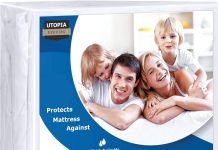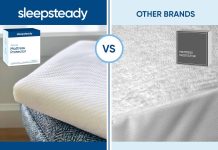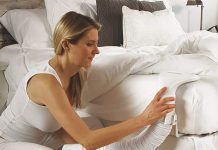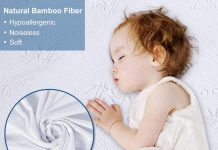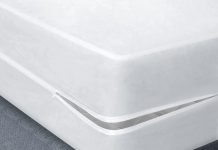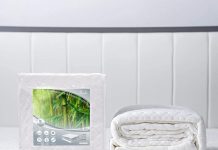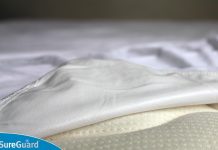I don’t know about you, but when it comes to replacing household items, I always find myself going down a rabbit hole of conflicting advice on the internet. It can be overwhelming, to say the least. So, when it comes to something as essential as mattress protectors, we wanted to set the record straight. In this article, we will explore the topic of how often mattress protectors should be replaced, giving you some expert tips and insights along the way. So put your worries to rest and let’s get started!
Review contents
Factors Affecting the Lifespan of Mattress Protectors
Quality of the Protector
The quality of the mattress protector is a crucial factor in determining its lifespan. Higher quality protectors are typically made with durable materials and construction techniques that can withstand regular use and washing. On the other hand, lower quality protectors may be prone to tearing or losing their protective properties over time. Investing in a high-quality mattress protector can significantly extend its lifespan and provide better overall protection for your mattress.
Frequency of Use
The frequency of use directly impacts the lifespan of a mattress protector. Mattress protectors that are used daily, such as in households with children or pets, may experience more wear and tear compared to those used less frequently. Regular use can cause the protector to stretch, accumulate dirt, or develop stains more quickly. It is important to be aware of how often your mattress protector is being used and adjust your replacement schedule accordingly.
Cleaning and Maintenance
Proper cleaning and maintenance practices can greatly affect the lifespan of your mattress protector. Regularly washing the protector according to the manufacturer’s instructions helps remove dirt, dead skin cells, and body oils that accumulate over time. This not only improves the overall hygiene of your sleep environment but also prevents these substances from breaking down the materials of the protector. Additionally, periodic inspections and spot cleaning can help identify and address any visible damage or stains before they worsen.
Environmental Factors
Environmental factors can also impact the lifespan of mattress protectors. Exposure to sunlight, humidity, and extreme temperatures can weaken the materials and decrease their effectiveness over time. Additionally, certain environmental conditions, such as a damp or mold-prone bedroom, can increase the likelihood of mold or mildew growth on the protector. It is important to consider your specific environment and take appropriate measures, such as using dehumidifiers or keeping the protector out of direct sunlight, to ensure its longevity.
Signs That Indicate a Need for Replacement
Visible Damage or Tears
One of the most obvious signs that a mattress protector needs to be replaced is visible damage or tears. Any holes, rips, or fraying edges compromise the protector’s ability to fully encase and protect the mattress. It is important to regularly inspect your mattress protector and promptly replace it if you notice any signs of damage.
Loss of Effectiveness
Over time, the protective properties of mattress protectors can diminish. This can include a decrease in waterproofing capabilities, reduced breathability, or diminished allergen resistance. If you find that your mattress protector is no longer providing the level of protection it once did, such as allowing liquids to seep through or not effectively blocking allergens, it may be time for a replacement.
Bad Odor or Stains
A mattress protector that emits unpleasant odors or has visible stains may be nearing the end of its lifespan. These odors and stains can be indicative of bacteria, mold, or mildew growth on the protector’s surface. While regular cleaning and spot treating can help mitigate these issues, persistent odors or stains may require a new protector to maintain a clean and hygienic sleep environment.
Allergies or Skin Irritation
If you or your sleeping partner experience increased allergies or skin irritation, it may be worth considering a replacement mattress protector. Over time, dust mites, allergens, and bacteria can accumulate on the surface of the protector, leading to allergic reactions or skin irritations. Replacing the protector can help reduce these issues and ensure a healthier sleep environment.
Specific Recommendations for Different Types of Mattress Protectors
Waterproof Mattress Protectors
Waterproof mattress protectors are designed to safeguard the mattress from spills, stains, and moisture. To prolong the lifespan of a waterproof protector, it is important to follow the manufacturer’s instructions for washing and drying. Some waterproof protectors may require additional care, such as air drying or low heat drying, to maintain their waterproof properties. It is also recommended to periodically test the waterproofing effectiveness of the protector by pouring a small amount of water on it and checking for any signs of leakage.
Anti-Allergen Mattress Protectors
Anti-allergen mattress protectors are specifically designed to create a barrier against common allergens such as dust mites, pet dander, and pollen. These protectors typically have specialized fabrics or coatings that prevent allergens from penetrating the surface. To maximize their lifespan, it is essential to regularly wash anti-allergen mattress protectors in hot water to kill any allergens that may have accumulated. Additionally, vacuuming the protector surface and using allergy-friendly cleaning products can help maintain their effectiveness.
Cooling Mattress Protectors
Cooling mattress protectors are engineered to regulate body temperature and provide a cooler sleep experience. These protectors often utilize breathable fabrics or cooling technologies that wick away heat and moisture. To extend the lifespan of a cooling mattress protector, it is important to avoid high heat drying, as it may damage the cooling properties. Gentle cycle washing with mild detergents and air drying can help preserve the cooling effectiveness and overall lifespan of the protector.
General Guidelines for Replacing Mattress Protectors
Manufacturer Recommendations
When considering the replacement of a mattress protector, it is advisable to consult the manufacturer’s guidelines and recommendations. Manufacturers often provide specific information regarding the expected lifespan of their protectors and any signs that indicate the need for replacement. Following these recommendations can help ensure optimal performance and longevity of the protector.
Approximate Lifespan
While the lifespan of a mattress protector can vary depending on various factors, such as quality and usage, a general guideline is to replace it every 1 to 2 years. However, if any of the signs mentioned earlier become evident before the suggested timeframe, it is recommended to replace the protector sooner. It is important to regularly evaluate the condition of your mattress protector and use common sense when determining if it needs replacement.
Check for Warranty Coverage
Some mattress protectors come with warranty coverage that guarantees protection against manufacturing defects or premature wear. Before replacing a mattress protector, it is advisable to check if it is still within the warranty period. If it is, contacting the manufacturer or retailer to inquire about a replacement or refund can be a cost-effective option.
Proper Care and Maintenance for Prolonging Mattress Protector Lifespan
Regular Cleaning
Regular cleaning is essential for maintaining the durability and effectiveness of a mattress protector. It is generally recommended to wash a protector every 1 to 3 months, depending on usage and personal preference. Following the manufacturer’s cleaning instructions, including water temperature and detergent recommendations, is crucial to avoid damaging the protector. Additionally, thoroughly drying the protector before reapplying it to the mattress helps prevent the growth of mold or mildew.
Avoiding Chemical-Based Cleaners
Chemical-based cleaners, such as bleach or harsh detergents, can potentially damage the materials of a mattress protector. It is best to avoid using these types of cleaners and opt for mild, eco-friendly detergents that are specifically formulated for sensitive fabrics. Additionally, spot treatments may be necessary for addressing localized stains. Before using any stain removers or spot cleaners, it is crucial to test them on a small, inconspicuous area of the protector to ensure it does not cause discoloration or damage.
Proper Handling and Storage
Proper handling and storage of a mattress protector can also significantly impact its lifespan. Avoid pulling or tugging the protector excessively during installation or removal, as this can strain the seams and possibly lead to tearing. Folding the protector neatly and storing it in a dry, cool area when not in use can help prevent unnecessary wear and tear. It is advisable to avoid storing the protector in direct sunlight or in areas with high humidity to minimize the risk of mold or mildew growth.
Benefits of Regularly Replacing Mattress Protectors
Improved Sleep Hygiene
Regularly replacing mattress protectors contributes to improved sleep hygiene by ensuring a clean and healthy sleep environment. With each replacement, you remove accumulated allergens, dirt, and bacteria that can negatively impact your sleep quality. A fresh protector provides a breathable and comfortable surface to sleep on, promoting a more restful and rejuvenating sleep experience.
Extended Mattress Lifespan
By providing an additional layer of protection against spills, stains, dust, and allergens, mattress protectors help extend the overall lifespan of your mattress. With regular replacements, you can maintain the integrity of your mattress and prevent potential damage or deterioration caused by moisture, excess wear, or allergen accumulation. This ultimately saves you money by delaying the need for a full mattress replacement.
Enhanced Allergy Protection
For individuals with allergies or sensitivities, regularly replacing mattress protectors is crucial for maintaining optimal allergy protection. Over time, allergens such as dust mites and pollen can accumulate on the surface of the protector, potentially causing or exacerbating allergic reactions. By replacing the protector, you remove allergens and create a cleaner sleep environment that promotes better respiratory health and reduces allergic symptoms.
Eco-Friendly Options for Replacement
Recycling Programs
When replacing a mattress protector, consider eco-friendly options such as recycling programs. Several organizations and mattress retailers offer recycling services for old mattress protectors. These programs enable you to responsibly dispose of your old protector by ensuring that its materials are recycled or repurposed rather than going to landfill. Research local recycling facilities or inquire with the manufacturer or retailer for details on their recycling initiatives.
Environmentally Sustainable Materials
Another eco-friendly option for replacing mattress protectors is to choose products made from environmentally sustainable materials. Look for protectors that are certified organic or made with materials that have minimal environmental impact. Some examples include protectors made from organic cotton, bamboo, or recycled materials. These options not only provide the necessary protection for your mattress but also contribute to reducing your carbon footprint.
Comparison of Mattress Protector Replacements to Mattress Replacements
Costs
In terms of costs, replacing a mattress protector is generally much more affordable compared to replacing an entire mattress. Good-quality mattress protectors can be found at various price points, allowing you to choose one that fits your budget. On the other hand, mattresses can be a significant investment, and the price varies depending on the size, brand, and materials. Regularly replacing mattress protectors can help extend the lifespan of your mattress, potentially saving you money in the long run.
Convenience
Replacing a mattress protector is a relatively simple and convenient process. They are typically lightweight and easy to remove and install on the mattress. In contrast, replacing a mattress can be a more time-consuming and physically demanding task. It often requires mattress delivery or removal services, coordination of schedules, and proper disposal of the old mattress. By regularly replacing mattress protectors, you can maintain the cleanliness and comfort of your sleep environment with minimal effort.
Effectiveness
While mattress protectors provide valuable protection and enhance the lifespan of a mattress, they cannot completely replace the need for a new mattress. Over time, mattresses can develop structural issues, lose their supportive properties, or become uncomfortable. If you are experiencing significant discomfort or prolonged back pain, it may be an indication that your mattress needs to be replaced. However, by using a high-quality mattress protector and replacing it regularly, you can help prolong the life of your mattress and maintain its functionality.
Tips for Selecting Quality Mattress Protectors
Read Customer Reviews
Reading customer reviews is an effective way to gain insight into the quality and performance of mattress protectors. Look for reviews that mention durability, ease of cleaning, and overall satisfaction. Pay attention to any recurring issues or concerns raised by multiple customers. This feedback can help you make an informed decision and select a quality mattress protector that suits your specific needs and preferences.
Consider Material and Features
When selecting a mattress protector, consider the materials and features that meet your requirements. Popular choices include cotton, polyester, and blends of different fabrics. Take into account factors such as breathability, waterproofing capabilities, and hypoallergenic properties. If you have specific preferences or concerns, such as sensitivity to certain fabrics or need for cooling features, prioritize those factors in your selection process.
Choose the Right Size
Ensure that you select a mattress protector that matches the size of your mattress. Most protectors come in standard sizes such as twin, full, queen, and king. However, it is always recommended to measure the dimensions of your mattress before purchasing to confirm a proper fit. A well-fitted protector not only provides effective coverage but also stays securely in place during use.
Conclusion
Regularly replacing mattress protectors is essential for maintaining a clean and hygienic sleep environment, enhancing the lifespan of your mattress, and protecting against allergens and stains. Factors such as the quality of the protector, frequency of use, and proper cleaning and maintenance all contribute to the overall lifespan of the protector. By following manufacturer recommendations, regularly checking for signs of damage or loss of effectiveness, and considering eco-friendly options, you can ensure the longevity and performance of your mattress protector. Remember to choose a protector that suits your needs, read customer reviews, and prioritize proper sizing for optimal protection. Taking these steps will not only provide a fresh and comfortable sleep surface but also contribute to better sleep hygiene, extended mattress lifespan, and enhanced allergy protection.



